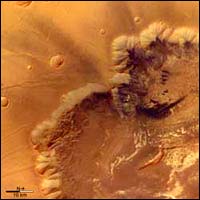The Valles Marineris canyon

Colour image of Melas Chasma
On 2 May 2004, the High-Resolution Stereo Camera (HRSC) on board the ESA Mars Express spacecraft obtained images from the central area of the Mars canyon called Valles Marineris.
The images were taken at a resolution of approximately 16 metres per pixel. The displayed region is located at the southern rim of the Melas Chasma at Mars latitude 12°S and Mars longitude 285°E. The images were taken on orbit 360 of Mars Express.
This region shows several clues to the morphological and geological development of the Valles Marineris. The images show many traces of volcanic activity and possibly water-related acitivity. However, a lot of the surface has been altered by subsequent geological processes, such as wind erosion and quakes.
Although many questions about the geological development of the Valles Marineris canyon have remained unanswered until now, the detailed HRSC image data may help to find some answers. Using HRSC data, scientists can focus on morphology – the evolution of rocks and land forms. They can also analyse the light relected by the canyon to understand which type of rocks it is made out of.
Media Contact
More Information:
http://www.esa.intAll latest news from the category: Earth Sciences
Earth Sciences (also referred to as Geosciences), which deals with basic issues surrounding our planet, plays a vital role in the area of energy and raw materials supply.
Earth Sciences comprises subjects such as geology, geography, geological informatics, paleontology, mineralogy, petrography, crystallography, geophysics, geodesy, glaciology, cartography, photogrammetry, meteorology and seismology, early-warning systems, earthquake research and polar research.
Newest articles

Zap Energy achieves 37-million-degree temperatures in a compact device
New publication reports record electron temperatures for a small-scale, sheared-flow-stabilized Z-pinch fusion device. In the nine decades since humans first produced fusion reactions, only a few fusion technologies have demonstrated…

Innovative microscopy demystifies metabolism of Alzheimer’s
Researchers at UC San Diego have deployed state-of-the art imaging techniques to discover the metabolism driving Alzheimer’s disease; results suggest new treatment strategies. Alzheimer’s disease causes significant problems with memory,…

A cause of immunodeficiency identified
After stroke and heart attack: Every year, between 250,000 and 300,000 people in Germany suffer from a stroke or heart attack. These patients suffer immune disturbances and are very frequently…





















